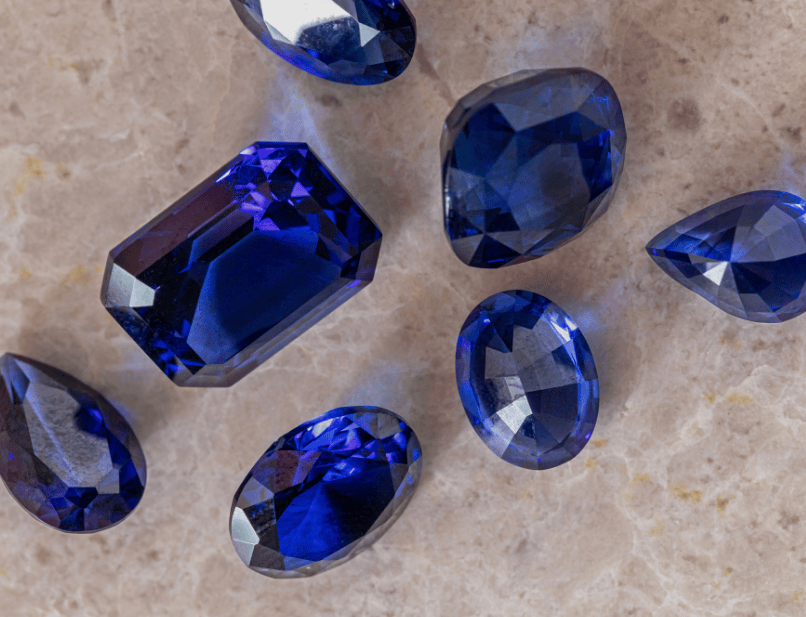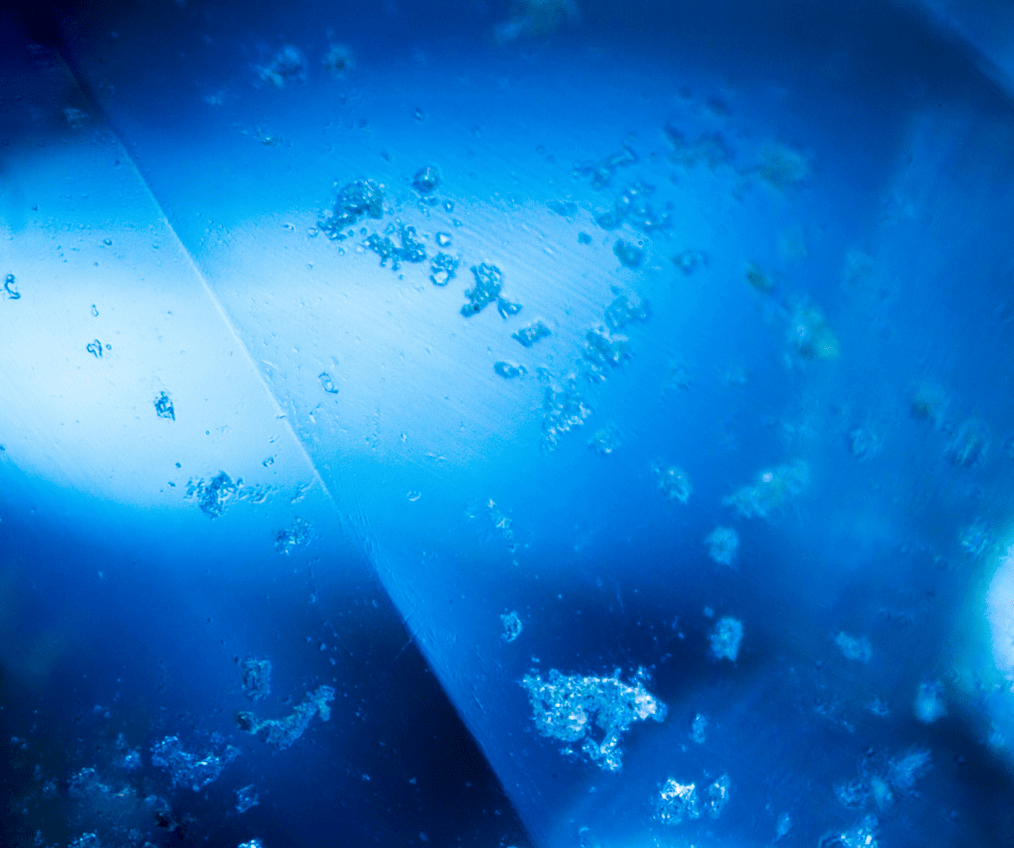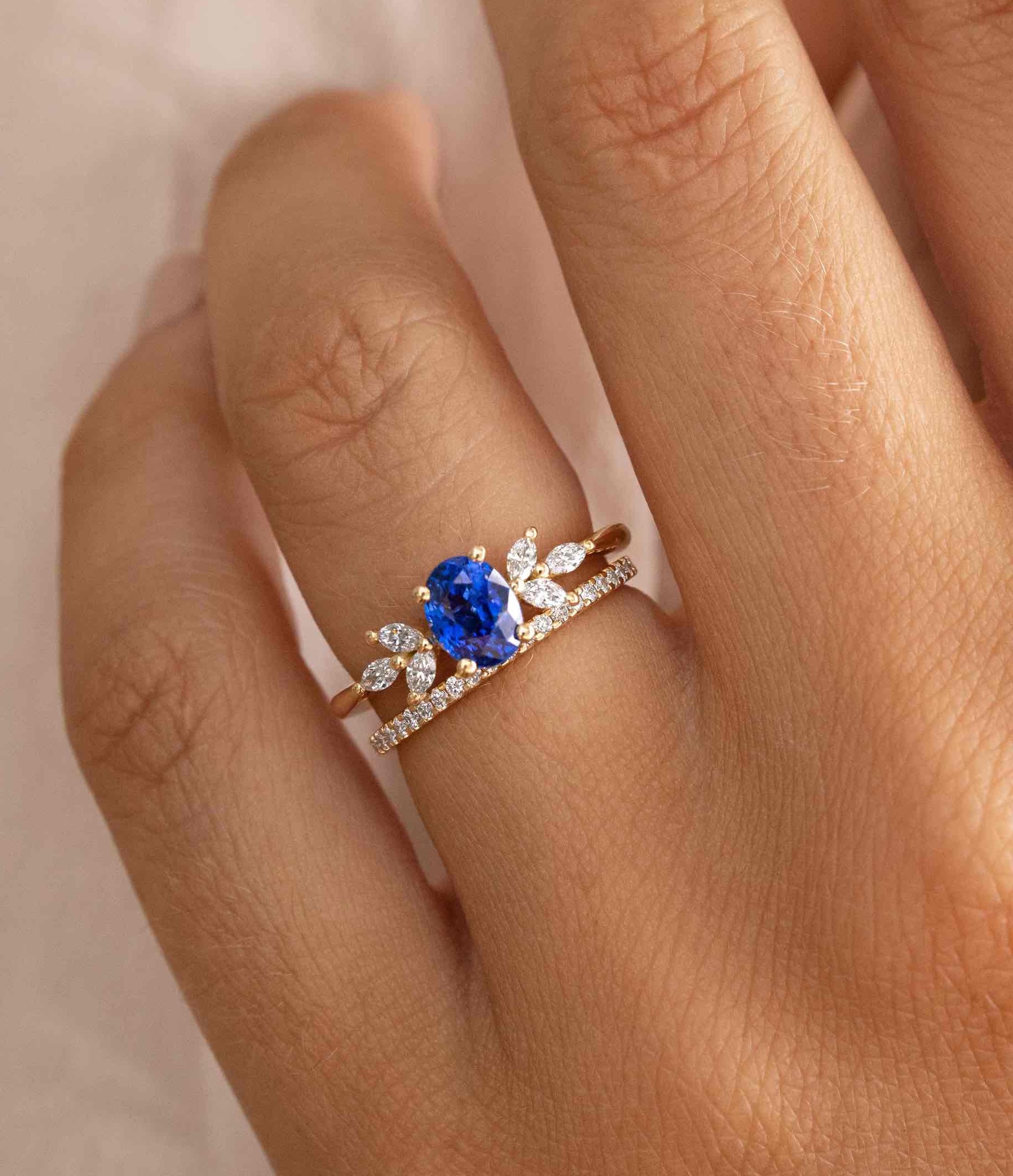
15 Feb 2025 — by Flawless Fine Jewellery — Reading time 12 minutes
All About Sapphire: The Ultimate Guide
The Knowledge You Need To Find Your Perfect Gemstone
Introduction to Sapphires
Sapphires have mesmerized jewellery lovers for centuries with their deep, rich hues, exceptional brilliance, and associations with wisdom and royalty. As one of the most prized gemstones, sapphires are valued for their durability, rarity, and versatility in fine jewellery. This guide explores everything about sapphires—their history, varieties, buying tips, and more—to help you make an informed choice, whether for an engagement ring, a bespoke jewellery piece, or simply to satisfy your curiosity about these dazzling gems.

Topics covered:
The History and Cultural Significance of Sapphires
The Colours of Sapphire
Types and Varieties of Sapphires
The Origin of Sapphires: Where They Are Found
Grading and Evaluating Sapphire Quality
Sapphire Treatments and Enhancements
Lab-Grown vs. Natural Sapphires
Famous Sapphires and Their Stories
Sapphire Jewellery: Trends and Designs
Caring for and Maintaining Sapphire Jewellery
Investing in Sapphires
Metaphysical and Healing Properties of Sapphires
Fun Facts and Trivia About Sapphires
Pricing of Sapphire Gemstones
Quality Grading and Gemmological Reports for Sapphire
FAQs
The History and Cultural Significance of Sapphires
Sapphires have played a significant role in history, symbolizing power, wisdom, and divine favour in various cultures:
Ancient Civilizations: The name “sapphire” derives from Latin sapphirus and Greek sappheiros, meaning “blue stone.” In ancient Persia, it was believed that the sky’s blue colour came from a massive sapphire beneath the heavens.
Medieval Europe: Sapphires were worn by royalty and clergy as symbols of wisdom, protection, and divine favour.
Indian and Buddhist Traditions: In ancient India, sapphires were linked to Saturn, believed to bring prosperity and spiritual enlightenment. Buddhists revered them for devotion, peace, and wisdom.
Roman Beliefs: Romans thought sapphires could ward off envy, harm, and negative energies.
Royalty and Power: Sapphires have adorned crowns, sceptres, and ceremonial jewellery as emblems of truth, sincerity, and authority, notably in the British Crown Jewels.

The Colours of Sapphire
Sapphires are renowned for their breathtaking range of colours. Here’s a quick guide to their diverse hues:
Blue Sapphires: The most iconic and sought-after variety, with shades ranging from light sky blue to deep royal blue. Their colour comes from trace elements of iron and titanium. The Hatton Garden Jewellers have a huge collection of blue Sapphires for the customers.
Pink Sapphires: Romantic and feminine, these range from soft pastel pinks to vibrant magenta tones.
Yellow Sapphires: Exude warmth and positivity, with hues varying from pale lemon to golden yellow.
Padparadscha Sapphires: Extremely rare, displaying a unique mix of pink and orange, reminiscent of a tropical sunset.
Green Sapphires: Subtle and earthy tones that range from pale green to olive.
Purple Sapphires: Rare stones that feature shades from lilac to deep violet.
Colourless (White) Sapphires: A brilliant and budget-friendly alternative to diamonds.
Colour-Change Sapphires: Unique gems that shift from blue in daylight to purple under artificial light.
Types and Varieties of Sapphires
Sapphires come in a variety of types and unique formations, each with its own appeal and characteristics. Here are the main types and varieties:
Natural Sapphires: Untreated gemstones that have been mined and cut without enhancements, prized for their authenticity and rarity.
Treated Sapphires: Heat-treated or chemically enhanced to improve colour and clarity, making them more affordable than untreated stones.
Star Sapphires: Display a unique star-like effect called asterism, caused by inclusions of rutile needles. These are highly sought after for their distinctive beauty.
Padparadscha Sapphires: A rare and valuable variety with a unique pink-orange hue resembling the colours of a lotus blossom or sunset.
Fancy Sapphires: Sapphires in colours other than blue, including pink, yellow, green, purple, and more. These are ideal for creating vibrant and unconventional jewellery pieces.
Colour-Change Sapphires: Exhibit a remarkable ability to change colour under different lighting conditions, typically shifting between blue and purple hues.
Synthetic Sapphires: Man-made gemstones created in laboratories, offering the same chemical composition as natural sapphires but at a lower cost.
The Origin of Sapphires: Where They Are Found
Sapphires are sourced worldwide, each location producing unique gems:
Sri Lanka (Ceylon): Renowned for high-quality Ceylon blue sapphires with vibrant hues and clarity.
Kashmir (India): Home to the rare, velvety-blue Kashmir sapphires, among the most prized in the world.
Myanmar (Burma): Produces rich, deeply saturated blue sapphires known as Burmese sapphires.
Madagascar: A leading sapphire source, offering a spectrum of colours.
Australia: Produces darker blue sapphires, often with a greenish hue.
Thailand: Famous for deep blue and fancy-coloured sapphires.
Other Notable Sources: Cambodia, Tanzania, and Montana (USA) also yield distinctive sapphires.

Grading and Evaluating Sapphire Quality
Sapphire quality is assessed based on several key factors:
Colour: The most critical aspect, with vivid, well-saturated hues being the most valuable.
Clarity: Fewer inclusions increase value; eye-clean sapphires are most desirable.
Cut: Well-cut sapphires enhance brilliance and symmetry.
Carat Weight: Larger sapphires are rarer and more valuable.
Treatments: Heat treatment is common; untreated sapphires are highly prized.
Origin: Sapphires from Kashmir, Burma, and Sri Lanka are often more valuable.
Certification: Trusted gemological labs like GIA and SSEF verify sapphire attributes.
Sapphire Treatments and Enhancements
Common sapphire treatments include:
Heat Treatment: Enhances colour and clarity; widely accepted in the market.
Diffusion Treatment: Alters the surface colour; results in lower-value sapphires.
Fracture Filling: Improves clarity but reduces durability and value.
Lattice Diffusion: Alters deep colour properties; requires disclosure.
Synthetic Sapphire: Lab-created, chemically identical but more affordable.

Lab-Grown vs. Natural Sapphires
Natural Sapphires: Formed over millions of years; rare and valuable.
Lab-Grown Sapphires: Created using advanced techniques; identical in composition but more affordable.
How to Differentiate: Natural sapphires have unique inclusions, while synthetic ones often show artificial growth lines.
Famous Sapphires and Their Stories
Iconic sapphires include:
The Star of India: A massive 563.35-carat star sapphire.
The Logan Sapphire: A 423-carat deep blue gem from Sri Lanka.
The Blue Belle of Asia: A rare 392.52-carat sapphire sold for record prices.
The Stuart Sapphire: A 104-carat royal blue sapphire in the British Crown Jewels.
Princess Diana’s Engagement Ring: A 12-carat oval sapphire surrounded by diamonds, now worn by Kate Middleton.
Sapphire Jewellery: Trends and Designs
Sapphires remain timeless in jewellery:
Engagement Rings: A stylish alternative to diamonds, inspired by royal choices.
Vintage & Art Deco Styles: Intricate designs with geometric patterns and diamond accents.
Coloured Sapphires in Fashion: Pastel hues and parti sapphires are growing in popularity.
Minimalist Designs: Sleek settings with bezel or solitaire styles.
Statement Jewellery: Large sapphire cocktail rings and bold bracelets.
Ethical & Sustainable Jewellery: Ethically sourced and lab-grown sapphires are gaining traction.
Sapphire Jewellery for Men: Signet rings, cufflinks, and bracelets with deep blue sapphires.
Custom & Bespoke Designs: Tailored jewellery pieces for unique personal styles.

Sapphire Jewellery: Trends and Designs
Sapphires remain timeless in jewellery:
Engagement Rings: A stylish alternative to diamonds, inspired by royal choices.
Vintage & Art Deco Styles: Intricate designs with geometric patterns and diamond accents.
Coloured Sapphires in Fashion: Pastel hues and parti sapphires are growing in popularity.
Minimalist Designs: Sleek settings with bezel or solitaire styles.
Statement Jewellery: Large sapphire cocktail rings and bold bracelets.
Ethical & Sustainable Jewellery: Ethically sourced and lab-grown sapphires are gaining traction.
Sapphire Jewellery for Men: Signet rings, cufflinks, and bracelets with deep blue sapphires.
Custom & Bespoke Designs: Tailored jewellery pieces for unique personal styles.
Investing in Sapphires
Sapphires are valuable investment assets due to their rarity, durability, and historical significance.
Key Considerations
Quality: Vivid colour, high clarity, well-proportioned cut, and larger carat sizes increase value.
Origin & Certification: Kashmir, Burma, and Sri Lanka sapphires are the most prized. Always seek certification from GIA, SSEF, or Gübelin.
Treatments: Untreated sapphires are rarer and more valuable than heat-treated stones. Avoid diffusion-treated or fracture-filled gems.
Market Demand: Blue and padparadscha sapphires show strong appreciation. Fancy-coloured sapphires are gaining popularity.
Resale & Protection: Certified natural sapphires have better resale potential. Store securely and insure your investment.

Metaphysical and Healing Properties of Sapphires
Sapphires have long been associated with spiritual, emotional, and physical well-being. Across cultures, they are believed to promote wisdom, clarity, and inner peace.
Spiritual and Emotional Benefits
Wisdom and Intuition: Traditionally linked to mental clarity, decision-making, and spiritual enlightenment.
Protection and Strength: Believed to shield against negative energies and promote emotional resilience.
Inner Peace: Associated with calmness, reducing stress, and fostering emotional balance.
Healing Properties
Mental Well-being: Thought to aid focus, relieve anxiety, and enhance meditation practices.
Physical Health: Some believe sapphires can support eye health, blood circulation, and detoxification.
Chakra Alignment: Blue sapphires are connected to the throat chakra, aiding communication and self-expression, while yellow sapphires are linked to the solar plexus for confidence and prosperity.
Fun Facts and Trivia About Sapphire
Sapphires are not only stunning but also rich in history, science, and culture. Here are some fascinating facts:
Historical and Cultural Facts
Name Origin: Derived from the Greek “sappheiros,” meaning “blue stone.”
Ancient Beliefs: Thought to protect against poisoning and envy in medieval times.
Royal Gem: Featured in the British Crown Jewels and Princess Diana’s iconic ring.
Scientific and Geological Facts
Composition: A variety of corundum, the second hardest mineral after diamond.
Not Just Blue: Also found in pink, yellow, green, and even colour-changing varieties.
Star Sapphires: Some display a star-like effect due to asterism.
Famous Sapphires
The Star of India: A 563-carat star sapphire.
The Logan Sapphire: A 423-carat deep blue gem in the Smithsonian.
Unusual Facts
September Birthstone: Symbolises wisdom, loyalty, and nobility.
Heat Treatment: Enhances colour and is widely accepted in the industry.
Space-Grade Durability: Used in spacecraft windows and high-tech equipment.
Pricing of Sapphire Gemstones
The price of sapphire gemstones varies based on several key factors:
1. Colour
Blue sapphires are the most common, with prices ranging from £100 to £10,000 per carat, depending on the intensity of the blue.
Fancy sapphires (e.g., Padparadscha) can be priced from £5,000 to £30,000+ per carat.
2. Carat Weight
Larger sapphires are more expensive. Prices for a 1-carat sapphire range from £500 to £3,000, while a 5-carat sapphire can cost £5,000 to £50,000+.
3. Clarity
Sapphires with high clarity (fewer visible inclusions) are more expensive, ranging from £1,000 to £10,000 per carat. Stones with visible inclusions can cost as low as £100 per carat.
4. Origin
Sapphires from regions like Sri Lanka, Kashmir, and Myanmar are highly prized. Kashmir sapphires can range from £2,000 to £25,000+ per carat.
5. Treatment
Untreated sapphires are generally more valuable, with prices ranging from £1,500 to £15,000 per carat. Treated sapphires are more affordable, priced from £300 to £3,000 per carat.
6. Cut and Shape
The cut affects the price, with well-cut sapphires costing more. Standard cuts range from £500 to £10,000 per carat, while custom cuts can exceed £20,000+ per carat.

Pricing of Sapphire Gemstones
The price of sapphire gemstones varies based on several key factors:
1. Colour
Blue sapphires are the most common, with prices ranging from £100 to £10,000 per carat, depending on the intensity of the blue.
Fancy sapphires (e.g., Padparadscha) can be priced from £5,000 to £30,000+ per carat.
2. Carat Weight
Larger sapphires are more expensive. Prices for a 1-carat sapphire range from £500 to £3,000, while a 5-carat sapphire can cost £5,000 to £50,000+.
3. Clarity
Sapphires with high clarity (fewer visible inclusions) are more expensive, ranging from £1,000 to £10,000 per carat. Stones with visible inclusions can cost as low as £100 per carat.
4. Origin
Sapphires from regions like Sri Lanka, Kashmir, and Myanmar are highly prized. Kashmir sapphires can range from £2,000 to £25,000+ per carat.
5. Treatment
Untreated sapphires are generally more valuable, with prices ranging from £1,500 to £15,000 per carat. Treated sapphires are more affordable, priced from £300 to £3,000 per carat.
6. Cut and Shape
The cut affects the price, with well-cut sapphires costing more. Standard cuts range from £500 to £10,000 per carat, while custom cuts can exceed £20,000+ per carat.
Short Description

FAQ’s
1. What is a sapphire?
A sapphire is a precious gemstone, primarily known for its blue colour, though it can come in various other colours (except red, which are considered rubies). It is a variety of the mineral corundum and is valued for its hardness, ranking 9 on the Mohs scale.
2. What is the most expensive sapphire?
The most expensive sapphires are those from Kashmir, known for their exceptional colour and rarity. Other highly valuable sapphires include those with vivid blue hues and rare colours like Padparadscha (a pink-orange sapphire).
3. How can you tell if a sapphire is real?
To identify a genuine sapphire, look for unique features such as colour zoning, natural inclusions (visible under magnification), and its hardness (sapphires are very hard and scratch-resistant). A gemological report can confirm its authenticity.
4. What is the difference between a sapphire and a ruby?
Both sapphires and rubies are varieties of corundum, but rubies are specifically red, while sapphires come in a range of colours. The primary difference lies in the colour, with rubies being red due to trace amounts of chromium.
5. Are sapphires treated?
Many sapphires undergo treatments to enhance their colour or clarity, the most common being heat treatment. Heat treatment is generally accepted in the industry, but untreated, natural sapphires are often more valuable.
6. How should I care for my sapphire?
To maintain a sapphire’s beauty, avoid exposure to harsh chemicals, excessive heat, or scratching. Clean it regularly with mild soap and warm water using a soft cloth or brush. Sapphires are durable but can be damaged by sharp blows or high-impact situations.
7. What is the birthstone associated with sapphires?
Sapphires are the birthstone for September, symbolising wisdom, loyalty, and nobility.
8. Are sapphires a good investment?
Sapphires can be a good investment, especially high-quality or rare stones. Their value is influenced by factors such as colour, size, clarity, and origin. However, as with any investment, it’s important to buy from reputable sources and seek professional advice.
9. How much does a sapphire cost?
Sapphire prices vary depending on factors like colour, carat weight, clarity, and origin. Generally, prices range from £100 to £30,000+ per carat, with the most valuable sapphires being those with excellent colour and clarity.
10. What is a Padparadscha sapphire?
Padparadscha is a rare and valuable type of sapphire that displays a unique pink-orange colour. These sapphires are highly sought after and can be significantly more expensive than standard blue sapphires.
11. Can sapphires be used in engagement rings?
Yes, sapphires are a popular choice for engagement rings due to their durability, beauty, and symbolism of wisdom and loyalty. Many famous engagement rings, including those of Princess Diana and Kate Middleton, feature sapphires.
12. How do I choose the right sapphire?
When choosing a sapphire, consider the colour, clarity, size, and cut. The most important factors are the vibrancy of the colour and the clarity of the stone. It’s also essential to buy from a reputable jeweller in Hatton Garden or request a gemmological report for added assurance.

